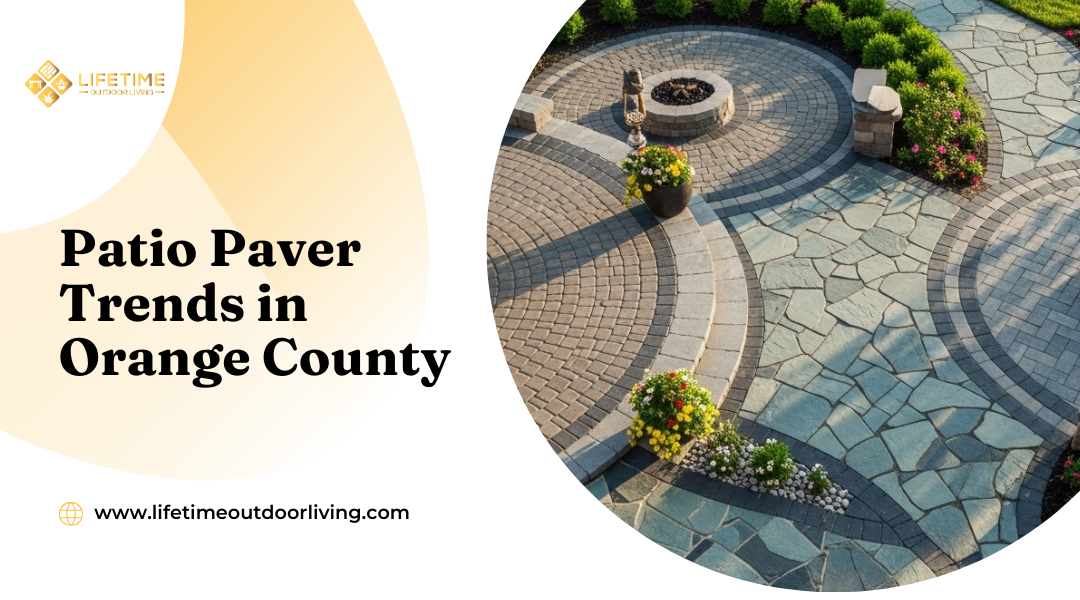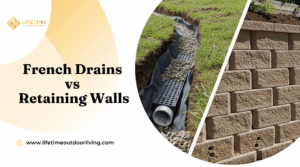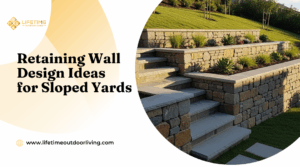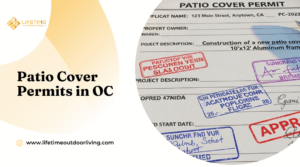When you upgrade your outdoor space in Orange County, patio pavers set the foundation for both style and function. They create durable, low-maintenance surfaces that elevate everything from driveways to pool decks. The top patio paver design trends in Orange County focus on clean geometric patterns, natural color palettes, and eco-friendly materials that blend beauty with long-term performance.
You see these trends shaping modern homes across Laguna Beach and beyond. Neutral tones like beige, gray, and brown pair seamlessly with contemporary architecture, while permeable pavers help manage water runoff in a sustainable way. Multi-functional layouts with fire pits, seating areas, and integrated lighting turn simple patios into year-round living spaces.
At Lifetime Outdoor Living, you gain access to premium materials and expert installation that bring these trends to life with precision. Whether you want a sleek modern driveway, a natural stone-inspired patio, or a custom outdoor design that fits your lifestyle, the right paver choice ensures your space looks timeless and performs for years to come.
Why Patio Pavers Are the Go-To Choice for Orange County Homes
Patio pavers provide a practical solution for outdoor living in Orange County by combining strength, visual appeal, and ease of upkeep. They adapt well to the coastal climate, enhance property value, and allow you to enjoy your outdoor space without constant maintenance.
Durability and Weather Resistance in Coastal Climates
In Laguna Beach and other coastal areas, salty air and occasional heavy rains can quickly wear down traditional concrete or asphalt. Pavers resist cracking and erosion because they are installed in interlocking patterns that allow for natural expansion and drainage.
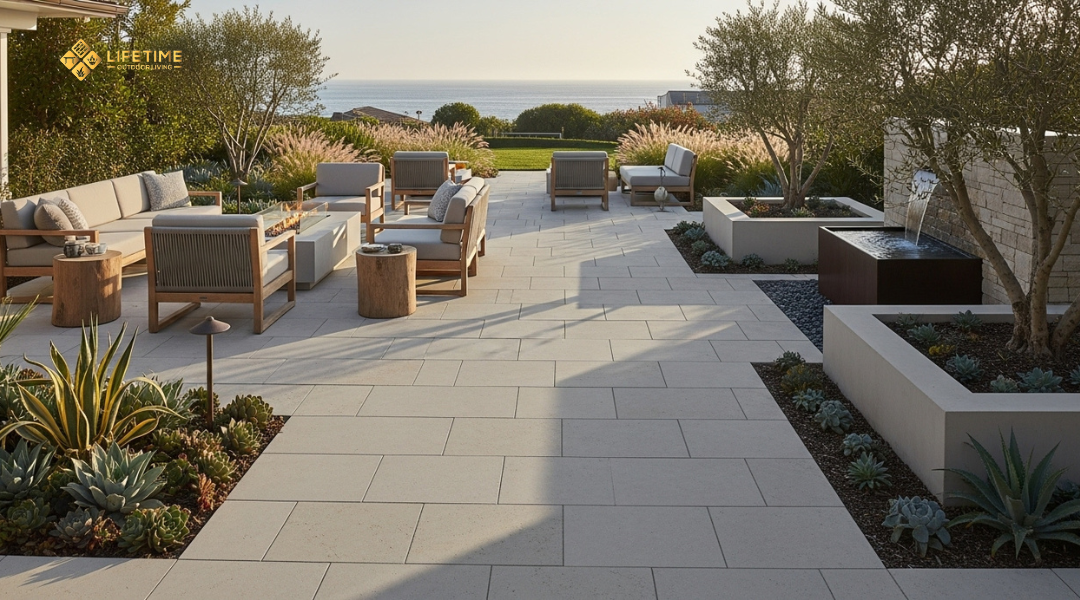
Unlike poured concrete, which can develop large fractures, individual pavers can be replaced if damaged. This makes them a cost-effective option over time, especially in climates where shifting soil and moisture are common.
Materials such as concrete pavers, natural stone, and porcelain hold up well against UV exposure and salt air. Their dense composition prevents premature fading and helps maintain a consistent appearance even after years of sun exposure.
If you want a surface that withstands daily use, coastal humidity, and temperature changes, pavers are a strong choice. Their proven durability ensures your patio or driveway remains functional and attractive for decades.
Boosting Curb Appeal and Home Value
Patio pavers offer a wide range of colors, shapes, and textures that allow you to match your outdoor space with the style of your home. From modern linear layouts to rustic cobblestone patterns, you can create a design that complements your property’s architecture.
Because they are modular, pavers can be arranged in custom patterns like herringbone, basketweave, or circular designs. This flexibility gives your home a more refined and intentional look compared to plain concrete.
Homes with well-designed paver patios, walkways, or driveways often stand out in Orange County’s competitive housing market. Buyers tend to view outdoor upgrades as valuable, especially when they combine aesthetics with long-term durability.
A properly installed paver surface not only improves curb appeal but also delivers a return on investment by making your home more appealing to potential buyers.
Low-Maintenance Outdoor Living Solutions
You don’t need to spend hours maintaining paver patios. Unlike wood decks that require sealing or staining, pavers only need occasional cleaning with water and mild detergent. Regular sweeping keeps debris from settling in the joints.
Weeds and moss can be minimized with polymeric sand between the joints, which hardens and prevents growth. If a section becomes stained or damaged, you can replace individual pavers without disturbing the entire surface.
Because they resist cracking, you avoid the costly repairs that often come with poured concrete. The modular design also means repairs are faster and less disruptive.
For homeowners in Orange County who want a functional outdoor space without heavy upkeep, pavers provide a balance of style and convenience that lasts year after year.
Current Patio Paver Design Trends in Orange County
Homeowners in Orange County are choosing patio designs that balance style with function. You see an emphasis on clean lines, coastal-inspired finishes, and materials that hold up well to the region’s outdoor lifestyle.
Modern Geometric Patterns (Herringbone, Chevron, Modular Layouts)
You can create a strong visual impact with geometric paver patterns. Designs like herringbone and chevron add movement and rhythm, while modular layouts provide a structured, grid-like appearance. These styles work well in both small courtyards and larger patios.
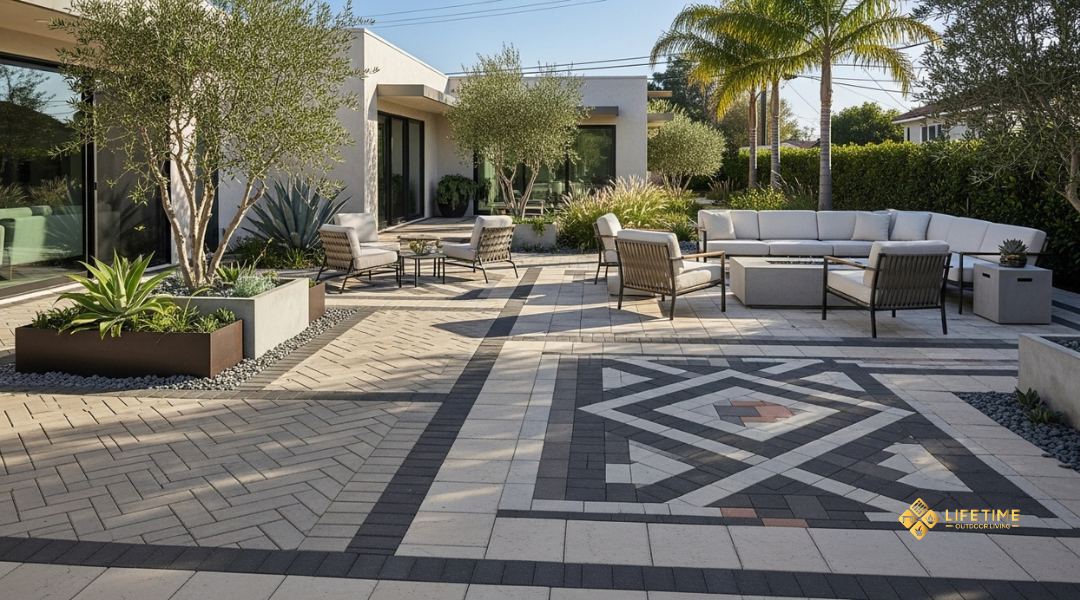
A herringbone layout often suits narrow spaces, as the angled design makes areas appear wider. Chevron patterns are sharper and more defined, giving a modern edge. Modular layouts are versatile, allowing you to mix square and rectangular pavers in repeating sequences.
When you choose geometric patterns, you also improve stability. Interlocking designs resist shifting, which is useful in high-traffic spaces. This combination of durability and style makes them a practical and modern choice for patios in Laguna Beach and surrounding coastal neighborhoods.
Natural Stone Looks for a Coastal Aesthetic
You can achieve a coastal look by using pavers that replicate natural stone textures. Materials with soft, irregular surfaces resemble limestone, sandstone, or slate, giving your patio a weathered, organic feel. This complements Orange County’s beachside environment.
Natural stone looks work well with both neutral and bold accents. For example, gray-toned pavers pair seamlessly with stainless steel outdoor kitchens, while sandy beige tones blend into landscaped gardens. The result is a space that feels integrated with the natural surroundings.
Unlike real stone, manufactured pavers that mimic stone are often easier to install and maintain. They resist salt exposure and coastal moisture better than many natural materials. This makes them a reliable option when you want the look of stone without the upkeep challenges.
Warm Earth Tones and Beach-Inspired Color Palettes
You can reflect the local landscape by selecting warm earth tones and beach-inspired colors. Shades like tan, buff, and soft gray evoke sand and driftwood, while muted blues or greens add subtle ocean-inspired accents.
This palette works especially well in outdoor living areas that connect to pools or gardens. The tones reduce glare under strong sunlight and create a softer, more inviting atmosphere. They also pair easily with natural wood furniture and coastal landscaping.
When you choose these colors, you ensure your patio feels consistent with the Laguna Beach environment. Instead of standing out sharply, the design blends with the surrounding scenery, giving your outdoor space a calm and cohesive look.
Mixed Materials: Combining Pavers with Turf or Gravel
You can add contrast and texture by combining pavers with turf strips or gravel borders. This technique breaks up large paved areas and introduces greenery or stone accents that soften the design.
For example, turf between pavers creates a grid effect that feels both structured and natural. Gravel inlays can highlight walkways or define seating zones without overwhelming the space. These combinations also improve drainage in areas prone to runoff.
Mixed-material layouts let you customize the look further. You can choose wide turf joints for a casual garden feel or narrow gravel lines for a modern, linear effect. This flexibility makes the approach appealing for patios of different sizes and styles.
Large Format Pavers for Sleek, Contemporary Spaces
You can achieve a minimalist look with large format pavers. Oversized slabs reduce the number of joints, creating a smooth, uninterrupted surface that feels modern and open.
These pavers work particularly well in contemporary homes with clean architectural lines. They also make smaller patios appear larger, as fewer seams draw the eye across the surface without interruption.
Large pavers are available in concrete, porcelain, and stone-look finishes. You can choose matte textures for a natural effect or polished surfaces for a more refined appearance. Their durability and low-maintenance qualities make them a strong choice for Orange County’s outdoor living spaces.
Functional Trends Shaping Outdoor Living Spaces
Design choices in hardscaping often balance aesthetics with usability. The right paver layouts and features not only enhance curb appeal but also improve safety, comfort, and the way you use each part of your property.
Multi-Level Patios and Outdoor Steps
Creating multiple levels with pavers helps you define zones for dining, lounging, or cooking. This approach works especially well if your yard has a slope, since steps and retaining walls can turn uneven ground into usable space.
You can use contrasting paver colors to visually separate each level. For example:
- Light tones for dining areas
- Neutral blends for walkways
- Darker shades for steps
Adding low-rise steps with textured finishes improves traction and safety. Proper lighting along edges ensures visibility at night, reducing the risk of trips and falls.
Multi-level designs also make your outdoor space feel larger by creating depth and dimension. They allow you to introduce features like planters or seating walls without overcrowding the main patio area.
Integrated Fire Pits and Outdoor Kitchens with Paver Bases
Pavers provide a durable foundation for fire pits and outdoor kitchens. They resist heat, stains, and heavy foot traffic, making them practical for spaces where people gather and cook.
When installing a fire pit, choose heat-resistant pavers around the perimeter. This protects the surface and keeps the area safe. For outdoor kitchens, a solid paver base helps support grills, counters, and appliances without shifting over time.
You can design the cooking and seating zones with complementary paver patterns. For instance, a herringbone layout under the kitchen area paired with a circular design around the fire pit creates visual separation.
Drainage is another key factor. Pavers with permeable joints allow water to filter through, reducing pooling near cooking or seating areas. This keeps the space functional in different weather conditions.
Pool Deck Pavers for Slip Resistance and Style
Pool decks benefit from pavers because they stay cooler underfoot and provide better traction than poured concrete. Textured surfaces reduce slipping hazards, which is especially important for families and frequent swimmers.
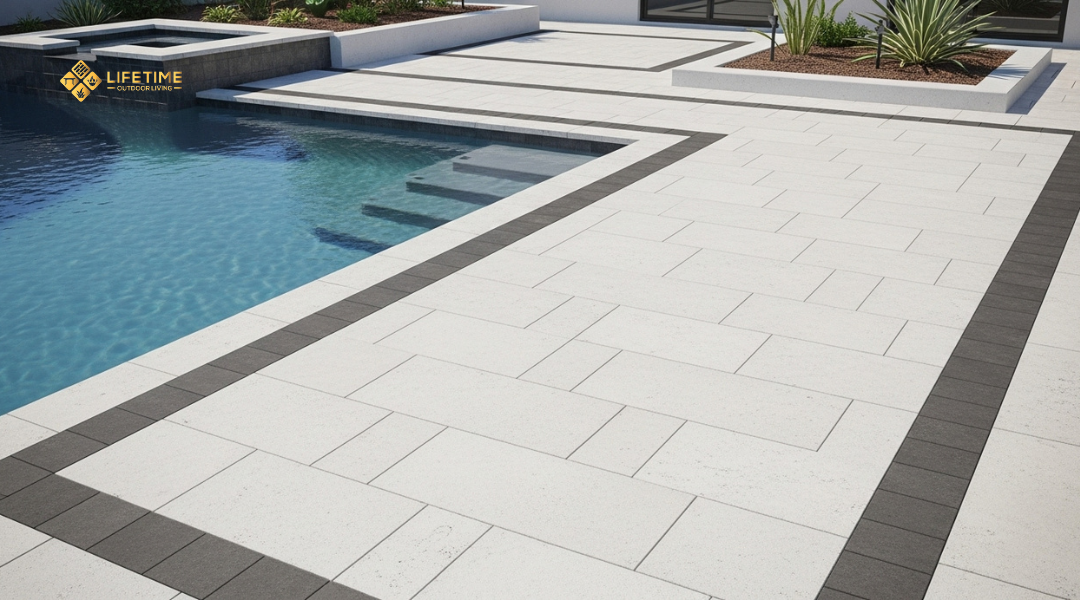
Materials such as travertine, porcelain, and textured concrete pavers combine safety with durability. They handle exposure to chlorine, saltwater, and sun without fading quickly.
You can also use paver patterns to frame the pool area. A border in a contrasting color helps define the edge, making the transition from deck to water more visible.
Maintenance is straightforward since individual pavers can be replaced if damaged. This makes them cost-effective over time compared to large slabs that may crack.
Driveways with Decorative Borders and Inlays
Driveway pavers allow you to combine strength with design flexibility. Unlike plain concrete, they can support heavy vehicles while offering a wide range of patterns and finishes.
Borders and inlays add detail that sets your driveway apart. For example:
- Contrasting borders in darker tones create a framed look
- Geometric inlays add symmetry and visual interest
- Natural stone blends give a softer, rustic appearance
Using pavers with textured surfaces improves traction for both vehicles and pedestrians. This is especially useful during rainy conditions.
Because each paver is interlocking, the surface can flex slightly under pressure, reducing the likelihood of cracks. This makes decorative driveways both practical and long-lasting.
Sustainable and Eco-Friendly Paver Options
When you choose patio pavers, you can reduce environmental impact while improving long-term performance. Options like permeable surfaces, recycled materials, and reflective finishes help conserve resources, manage water, and create more comfortable outdoor spaces.
Permeable Pavers for Water Conservation
Permeable pavers allow rainwater to filter through joints or porous surfaces instead of running off into storm drains. This design helps recharge groundwater and reduces the risk of localized flooding after heavy rainfall.
In Orange County, where water management is a priority, these systems can also support rainwater harvesting. By directing water into the soil, you reduce erosion and help maintain healthier plant growth around your patio.
Maintenance is straightforward but important. You’ll need to occasionally clean debris from the joints to keep water flowing freely. Compared to traditional concrete or asphalt, permeable pavers provide a functional surface that blends durability with responsible water use.
Key benefits:
- Reduces stormwater runoff
- Improves local drainage
- Supports landscape irrigation through natural absorption
Locally Sourced and Recycled Materials
Using pavers made from recycled aggregates or reclaimed stone lowers the demand for new raw materials. Many manufacturers now offer products that incorporate crushed concrete, glass, or reclaimed brick without sacrificing strength or appearance.
Locally sourced stone or clay pavers also reduce transportation emissions. Choosing suppliers within Southern California helps minimize the environmental footprint of your project.
You can still achieve a wide range of styles. Recycled concrete pavers often mimic natural stone, while reclaimed brick adds character and variation in color. These materials balance sustainability with design flexibility, giving you a patio that looks high-end while reducing waste.
Examples of sustainable sources:
- Crushed concrete aggregate
- Reclaimed clay brick
- Locally quarried natural stone
Energy Efficiency and Heat-Reflective Surfaces
Outdoor surfaces can contribute to higher temperatures around your home, especially in sunny climates. Heat-reflective or “cool” pavers are designed to absorb less heat, lowering surface temperatures during the day.
This feature reduces the urban heat island effect and makes patios more comfortable for walking barefoot in summer. In Laguna Beach, where outdoor living is common, reflective pavers help extend usability of your space without added cooling systems.
Some products are rated by their Solar Reflectance Index (SRI), which measures how well a surface reflects sunlight and releases heat. Choosing pavers with a higher SRI can also improve energy efficiency by reducing heat transfer to nearby walls and windows.
Advantages of reflective pavers:
- Cooler surface temperatures
- Increased comfort in hot weather
- Lower energy demand for surrounding buildings
How Lifetime Outdoor Living Brings These Trends to Life
You can expect a balance of design flexibility, durable materials, professional installation, and neighborhood-specific expertise. Every project is built with attention to detail, ensuring your outdoor space reflects both your lifestyle and the character of your home.
Customized Designs to Match Each Home’s Architecture
Your home’s architecture sets the tone for how your patio should look and function. Lifetime Outdoor Living creates layouts that align with the style of your property, whether you own a coastal cottage, a modern hillside home, or a Spanish-inspired residence.
Designs are tailored through careful planning of paver shapes, sizes, and colors. For example, sleek rectangular pavers complement contemporary homes, while tumbled stone blends better with traditional or rustic designs.
The design process also accounts for how you use the space. If you entertain often, larger open patterns may be recommended. For smaller yards, tighter layouts with defined borders can maximize usable space without overwhelming the area.
By focusing on architectural harmony, you gain a patio that looks intentional rather than added on. This approach ensures the finished project feels like a natural extension of your home.
Wide Selection of Premium Paver Materials
You have access to a range of materials that balance durability with design appeal. Lifetime Outdoor Living works with concrete pavers, natural stone, and permeable options that support both aesthetics and function.
Concrete pavers are versatile, available in many shapes and finishes, and require minimal upkeep. Natural stone, such as travertine or slate, provides a more organic look and pairs well with Laguna Beach’s coastal setting.
Permeable pavers are also available for homeowners who want improved drainage and reduced water runoff. These systems use open-graded stone bases, allowing water to filter through instead of pooling on the surface.
With multiple textures and finishes, you can choose between smooth, modern surfaces or more textured, slip-resistant options. This variety helps you match both your design preference and practical needs.
Licensed, Bonded, and Insured Craftsmanship in Laguna Beach
When you hire a paving contractor, you want assurance that the work is done correctly and responsibly. Lifetime Outdoor Living is licensed, bonded, and insured, which protects both you and your property during every stage of the project.
Licensed contractors meet state requirements for training and standards. Bonding provides financial coverage if a project is not completed as agreed. Insurance protects against accidents or property damage during installation.
This combination gives you confidence that your investment is safeguarded. It also means the crew working on your property follows established guidelines for safety and quality.
By maintaining these credentials, the company demonstrates accountability and professionalism in every project, from small walkways to full outdoor living spaces.
Local Expertise Across Orange County Neighborhoods
Your patio needs may vary depending on where you live in Orange County. Lifetime Outdoor Living understands the differences between coastal, hillside, and inland properties, which allows for more precise planning.
In Laguna Beach, salt air and moisture require materials with strong resistance to corrosion and staining. In inland areas like Irvine or Tustin, heat retention and shade planning play a larger role in design.
The company’s experience across different neighborhoods helps anticipate challenges such as soil conditions, drainage, and HOA requirements. This knowledge saves you time and reduces the chance of costly adjustments later.
By tailoring solutions to local conditions, you receive a patio that not only looks good but also performs well in your specific environment.
Choosing the Right Paver Design for Your Home
Selecting the right paver design depends on how you plan to use the space, the architectural style of your home, and the specific conditions of your property. Local preferences and climate also play a role in which materials and layouts will perform best over time.
Factors to Consider: Style, Functionality, Budget
Start by matching the paver design to your home’s style. A modern house may look best with large-format concrete slabs in clean lines, while a coastal cottage might pair well with tumbled stone or rustic brick. Consistency between your home’s architecture and outdoor space creates a balanced look.
Functionality is equally important. If you want a patio for entertaining, consider smooth, level pavers that accommodate outdoor furniture. Driveways and walkways may need thicker, high-strength pavers to handle weight and heavy use. Slip resistance is also essential around pools or areas exposed to water.
Budget influences both materials and design complexity. Concrete pavers are usually the most cost-effective and long-lasting, while natural stone such as travertine or bluestone provides a premium appearance at a higher price. Setting a clear budget helps you narrow choices without compromising durability.
Popular Choices in Irvine, Newport Beach, and Laguna Beach
In Orange County, climate and lifestyle guide material preferences. Concrete pavers remain popular for their durability and wide range of colors, especially in Irvine where modern homes often favor sleek, uniform finishes.
Travertine is frequently chosen in Newport Beach for patios and pool decks. Its natural variation and ability to stay cooler underfoot make it practical for sunny coastal properties. Porcelain pavers are also gaining attention for their low maintenance and resistance to staining.
Laguna Beach homeowners often lean toward natural stone like limestone or bluestone, which complements the area’s coastal landscapes. These stones add character and blend well with outdoor spaces that emphasize a connection to nature.
Why Working with a Local Contractor Matters
A local contractor understands Orange County’s specific conditions, from soil stability to coastal weather. This knowledge helps you avoid issues like shifting pavers or premature wear.
Local expertise also ensures compliance with city codes and HOA requirements, which can vary between communities. Contractors familiar with Irvine, Newport Beach, and Laguna Beach streamline the approval process and reduce delays.
Working with a nearby company also gives you access to regional suppliers. This often means faster delivery, better material selection, and designs that reflect current neighborhood trends. With local support, your project benefits from both practical knowledge and long-term reliability.

